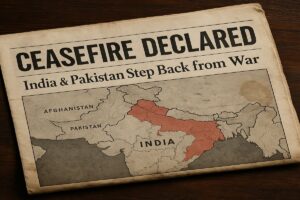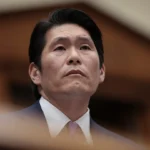⚡ Cutting through noise. Spotlighting the truth.
India Pakistan Ceasefire Follows U.S. Mediation

Tensions between India and Pakistan once again reached a boiling point this May, bringing two nuclear powers dangerously close to open war. Deadly attacks in Kashmir triggered a sharp military response from both sides, leading to drone and missile strikes that shocked the world. But in a surprising diplomatic turn, the India Pakistan ceasefire was announced, thanks in large part to U.S.-led mediation efforts. Now, both nations cautiously step back from the brink.
Key Escalation: Deadly Attack in Kashmir
The conflict began with bloodshed in Indian-administered Kashmir. A terrorist bombing in April 2025 took numerous lives in the town of Pahalgam, reigniting fears of insurgency and retaliation. Both India and Pakistan responded with heightened military activity along the Line of Control. According to CBS News, missile and drone exchanges marked the peak of the hostilities, shocking observers and populations on both sides.
Military analysts pointed to a significant rise in troop presence by early May. Public concern exploded online and in local media, with nuclear fear trending across social platforms. As military rhetoric intensified, the situation became untenable for both governments and their citizens.
Breakthrough via U.S. Diplomacy
In a moment reminiscent of classic shuttle diplomacy, the United States stepped in forcefully. Over 48 hours, high-level officials worked to cool tempers and bring both sides to the table. U.S. Secretary of State Marco Rubio and Vice President JD Vance led the charge, talking directly with senior leaders from both India and Pakistan.
Ultimately, President Donald Trump announced the breakthrough. In his own words: “After a long night of talks mediated by the United States, I am pleased to announce that India and Pakistan have agreed to a full and immediate ceasefire.” According to Politico EU, both governments quickly confirmed the deal and committed to initiate broader peace talks in a neutral setting.
It’s a remarkable turn of events. In a region where border disputes and nationalist politics often crush diplomacy, the ceasefire’s swiftness highlights the effectiveness of patient, direct negotiation. It also gives renewed weight to Trump’s foreign policy credentials after years of controversy.
Global Reactions and Risk of Nuclear Escalation
While domestic audiences in both countries appeared relieved, global stakeholders were even more so. The fear of nuclear war was not just hypothetical. With both countries showcasing powerful military hardware, including medium-range ballistic capabilities, the threat was very real.
Cybernews and CBS both highlighted the digital panic that spread during the clashes, as hashtags warning of world war made rounds on international social media. Neighboring countries like China and Iran reportedly waited in heightened readiness, anticipating potential outcomes.
The ceasefire, therefore, doesn’t just affect India and Pakistan. Conflicts invite potential involvement from regional powers and alliances. Stabilizing hotspots like Kashmir is in everyone’s interest.
Why the India Pakistan Ceasefire Matters Now
Ending the violence before it spiraled further was no small achievement. Not only did this agreement stop active fighting, but it may also pave the way for broader discussions about the Kashmir conflict, troop deployments, and potentially renewed trade cooperation.
Crucially, the timing of the India Pakistan ceasefire is telling. The violence escalated quickly, but it was also contained quickly—with American leadership steering the ship. While previous administrations often waded carefully on South Asian issues, the current U.S. administration stepped in assertively.
That speaks volumes about a change in foreign policy philosophy. Rather than defer to multilateral institutions or vague “norms,” this White House favored action, even if it ruffled an official in Brussels or New York. That’s the kind of decisive leadership more global hot zones could use.
Expert Insights
U.S. Secretary of State Marco Rubio offered a candid glimpse into the negotiations. “Over the past 48 hours, Vice President JD Vance and I have engaged with senior Indian and Pakistani officials to bring about this ceasefire,” he told reporters. “The two governments agreed to start talks on a broad set of issues at a neutral site.”
Rubio’s remarks reflect a broader stance on nationalism and foreign engagement. Related themes were echoed in his recent comments on political crackdowns in Europe, including Rubio Slams Germany’s AfD Crackdown, which drew sharp reactions abroad.
Contrasting Views
Of course, this diplomatic success isn’t without critics. Some voices on the left argue that this deal may be temporary, pointing to past ceasefires in South Asia that crumbled within months. Others worry that this could legitimize military aggression as a bargaining tactic, especially if no concrete gains are made in long-term peace talks.
Meanwhile, conservatives tend to highlight the strength-based negotiation style used by the U.S. and the positive outcome it produced. They argue that the ceasefire demonstrates how proactive diplomacy with clear consequences can outweigh drawn-out dialogue.
In truth, both sides have a point. The road to lasting peace in Kashmir remains long and pockmarked with setbacks. But it’s hard to dismiss the value of a moment that stopped missiles midflight and redirected attention to the negotiating table.
Reader Questions
Why did India and Pakistan agree to a ceasefire now?
After days of airborne military strikes and mounting casualties, both nations faced severe internal and global pressure to avoid full-scale war. The U.S. stepped in with direct mediation and helped facilitate a deal on May 10, 2025. Miscalculation between nuclear powers was a risk no one wanted.
What role did the U.S. play in the ceasefire?
President Donald Trump, Secretary of State Marco Rubio, and Vice President JD Vance played key roles in 48 hours of high-level dialogue with both governments. Their mediation was central to finalizing the ceasefire agreement and getting both sides to commit to further talks.
What triggered the latest India-Pakistan clashes?
The immediate trigger was a deadly terrorist bombing in Pahalgam, located in Indian-administered Kashmir. India blamed Pakistan-based militants, prompting counterstrikes and rapid escalation in border skirmishes.
Wrap-Up
- India and Pakistan agreed to a U.S.-brokered ceasefire on May 10, 2025
- The violence followed a major terrorist attack and days of military exchanges
- U.S. officials like Trump, Rubio, and Vance led successful mediation
- The India Pakistan ceasefire could pave the way for longer-term talks
- Nuclear fears and public pressure underscored the urgency of peace




